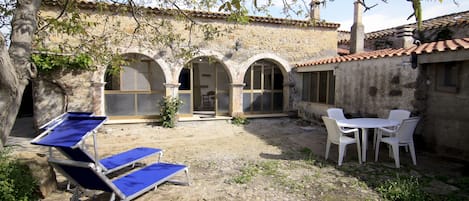My house is very comfortable, located on the first floor with very generous interior spaces, with balcony and entrance terrace, large kitchen and comfortable bedrooms, in the lounge there is a fireplace, large kitchen with kitchenette and oven, air conditioning system and plenty of hot water, garden and parking space.
Located in central-southern Sardinia, 75 kilometers from Cagliari, with a thousand-year history, characterized by archaeological sites and ancient traditions. Until the mid-twentieth century, most of its fields were cultivated with nuragus, a vine that takes its name from the village and from which a fine white wine is made.
The country boasts a strategic position for excursions throughout the island, in the immediate vicinity many important archaeological sites, such as Nuraghe Arrubiu in Orroli, Nuragic Sanctuary Santa Vittoria in Serri, Royal Palace in Barumini the most important Nuragic complex in Sardinia, in addition in the district there are hundreds of archaeological sites that can be visited such as sacred wells, domus de Janas, Romanesque churches, etc. at the foot of the Giara plateau an extension of flat area of 45 square km where you can admire wild ponies, for lovers of rock climbing we find Isili and its cliffs, also nature trails and horseback riding, in Laconi the Aymerich botanical paradise park and the medieval castle, for those who love the sea there is plenty of choice, to get to the Oristanese beaches you have to travel 50 km, those of Cagliaritano 70 km and those of Ogliastra 100 km.
The Aymerich park. Laconi is a botanists' paradise and reserves infinite surprises for those who carefully explore its territory.
It is a garden that has the highest number of Sardinian orchid species: some of them clearly bear its name (ophris laconensis, orchis sarcidani) .A land that hides, in lesser known corners, rarities such as pyracanta coccinea (the only finding Sardinia). In the territory there are the holm oak, the olive, the downy oak, the cork oak, the bagolaro, the carob tree and the most varied Mediterranean essences. Inside the Aymerich Garden we can admire the gigantic Himalayan cedar, the Pendulo beech, the collectia cruciata (a rare plant with leaves that recall many small fighter planes in the form).
You can admire the magnolia grandiflora, the thuia orientalis and the taxus baccata, known as the "Tree of Death". But it is within the park that we can observe the countless botanical species, among which the majestic cedar of Lebanon and the Corsican pine cannot go unnoticed.
Sport climbing in Isili. The walls of Isili have become over the years among the most popular in Sardinia and Europe, the routes of Isili are all registered in the climbing guide Pietra di Luna, published in 4 languages by Fabula and edited
by Maurizio Oviglia. The guide is regularly updated every 7/8 years. News and new nailing operations are published regularly on the websites www. sardiniaclimb. com and www. pietradiluna. com.
Archaeological Area "Su Nuraxi". Visiting Barumini and its territory means going to the discovery of a world rich in history and tradition. From the first moments in which you approach this small center of the Marmilla, located in the heart of Sardinia, you breathe a particular air, that of a special place, appointed since ancient times as the seat of power and central part of a territory flourishing and full of wonders as well as a fundamental means of communication.
The most important of the testimonies of this glorious past is undoubtedly the Su Nuraxi archaeological area. Discovered and brought to light during the 1950s, during the excavations conducted by the great archaeologist Giovanni Lilliu, the area consists of an imposing complex nuraghe, built in different phases starting from the 15th century BC. C., and an extensive village of huts that developed all around over the following centuries. A unique place of its kind and for this reason, since 1997, recognized by UNESCO as a World Heritage Site.
On the Giara horse, we can say that it was introduced to the island by the Phoenicians and reawakened in the plateau, there are over 600 specimens. Genoni houses a custody center and, above all, the Cavallino della Giara museum, housed in a Campidanese house. Here you will also find out about the agro-pastoral culture of the country, which includes other religious festivals, such as the fires of Saint Anthony the Abbot in January, the rural festival of Saint Isidore and that of the Madonna of the Sacred Heart, both in May.
Distance from Cagliari-Elmas airport about 60 Kilometers.





